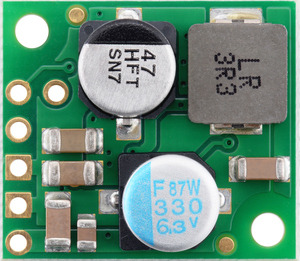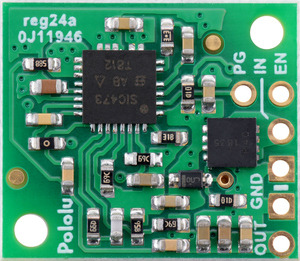

















Description
This small synchronous switching step-down (or buck) regulator takes an input voltage of up to 50 V and efficiently reduces it to 5 V. The board measures only 0.7″ × 0.8″ yet delivers typical maximum continuous output currents between 2.5 A and 4 A, depending on the input voltage, which makes it well suited for powering moderate loads like sensors or small motors. An optional enable input with a precise cutoff threshold can be used to put the regulator in a low-power state with a current draw of 10 µA to 20 µA per volt on VIN. The regulator also features reverse voltage protection and a power-good output that indicates when the regulator cannot adequately maintain the output voltage. The pins have a 0.1″ spacing, making this board compatible with standard solderless breadboards and perfboards.
Overview
 |
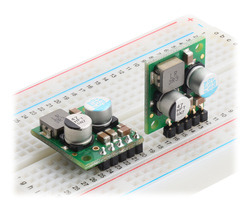 |
|
Step-Down Voltage Regulator D36V28Fx, assembled on breadboard. |
|---|
The D36V28Fx family of buck (step-down) voltage regulators generates lower output voltages from input voltages as high as 50 V. They are switching regulators (also called switched-mode power supplies (SMPS) or DC-to-DC converters), which makes them much more efficient than linear voltage regulators, especially when the difference between the input and output voltage is large. These regulators can typically support continuous output currents between 2 A and 4 A, depending on the input voltage and output voltage (see the Maximum continuous output current section below). In general, the available output current is a little higher for the lower-voltage versions than it is for the higher-voltage versions, and it decreases as the input voltage increases.
This family includes six versions with fixed output voltages ranging from 3.3 V to 12 V:
- D36V28F3: Fixed 3.3V output
- D36V28F5: Fixed 5V output
- D36V28F6: Fixed 6V output
- D36V28F7: Fixed 7.5V output
- D36V28F9: Fixed 9V output
- D36V28F12: Fixed 12V output
The regulators have reverse voltage protection up to 40 V, output undervoltage and overvoltage protection, over-current protection, and short-circuit protection. A thermal shutdown feature also helps prevent damage from overheating and a soft-start feature limits the inrush current and gradually ramps the output voltage on startup.
If you need more output current, consider the very similar D36V50Fx family of step-down voltage regulators.
We manufacture these boards in-house at our Las Vegas facility, which gives us the flexibility to make these regulators with customized components to better meet the needs of your project. For example, if you have an application where the input voltage will always be below 20 V and efficiency is very important, we can make these regulators a bit more efficient at high loads by replacing the 40V reverse voltage protection MOSFET with a 20V one. We can also customize the output voltage. If you are interested in customization, please contact us.
|
|
Features
- Input voltage: 5.3 V to 50 V (minimum input subject to dropout voltage considerations; see the dropout voltage section for details)
- Output voltage: 5 V with 4% accuracy
- Typical maximum continuous output current: 2.5 A to 4 A (see the maximum continuous output current graph below)
- Typical efficiency of 80% to 90%, depending on input voltage, output voltage, and load (see the efficiency graph below)
- Switching frequency: ~500 kHz under heavy loads
- Power-save mode with ultrasonic operation that increases light load efficiency by reducing switching frequency, but keeps it above the audible range (20 kHz)
- 2 mA to 3 mA typical no-load quiescent current (see the quiescent current graph below)
- Enable input with precise cutoff threshold for disconnecting the load and putting the regulator into a low-power state that draws approximately 10 µA to 20 µA per volt on VIN
- “Power good” output indicates when the regulator cannot adequately maintain the output voltage
- Output undervoltage and overvoltage protection
- Soft-start feature limits inrush current and gradually ramps output voltage
- Integrated reverse-voltage protection up to 40 V, over-current and short-circuit protection, over-temperature shutoff
- Compact size: 0.7″ × 0.8″ × 0.345″ (17.8 mm × 20.3 mm × 8.8 mm)
- Two 0.086″ mounting holes for #2 or M2 screws
Connections
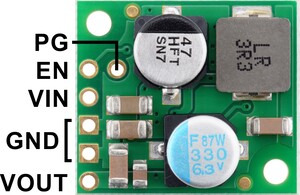 |
This regulator has six connections: power good (PG), enable (EN), input voltage (VIN), output voltage (VOUT), and two ground (GND) connections.
The “power good” indicator, PG, is an open-drain output that goes low when the regulator’s output voltage either rises more than 20% above or falls more than 10% below the nominal voltage (with hysteresis). An external pull-up resistor is required to use this pin.
The regulator, which is enabled by default, can be put into a low-power sleep state by reducing the voltage on the EN pin below 1.2 V, and it can be brought out of this state again by increasing the voltage on EN past 1.35 V. The quiescent current draw in this sleep mode is dominated by the current in the 100 kΩ pull-up resistor from ENABLE to VIN and in the reverse-voltage protection circuit, which altogether will be between 10 µA and 20 µA per volt on VIN. The tight tolerance of the enable input allows a precise low-VIN cutoff to be set, such as with the output of an external voltage divider powered by VIN, which is useful for battery powered applications where draining the battery below a particular voltage threshold could permanently damage it.
The input voltage, VIN, powers the regulator. Voltages up to 50 V can be applied to VIN. Generally, the effective lower limit of VIN is VOUT plus the regulator’s dropout voltage, which varies approximately linearly with the load (see below for graphs of the dropout voltage as a function of the load).
VOUT is the regulated output voltage.
 |
|
Step-Down Voltage Regulator D36V28Fx, with included hardware. |
|---|
The six connections are arranged on a 0.1″ grid for compatibility with solderless breadboards, connectors, and other prototyping arrangements that use a 0.1″ grid. The PG connection is the only one not located along the edge of the board. A 6×1 straight male header strip and a 5×1 right-angle male header strip are included with the regulator; one pin of the straight header can optionally be broken off and soldered into PG.
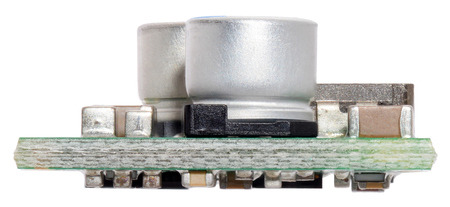 |
|
Step-Down Voltage Regulator D36V28Fx, side view. |
|---|
Typical efficiency
The efficiency of a voltage regulator, defined as (Power out)/(Power in), is an important measure of its performance, especially when battery life or heat are concerns.
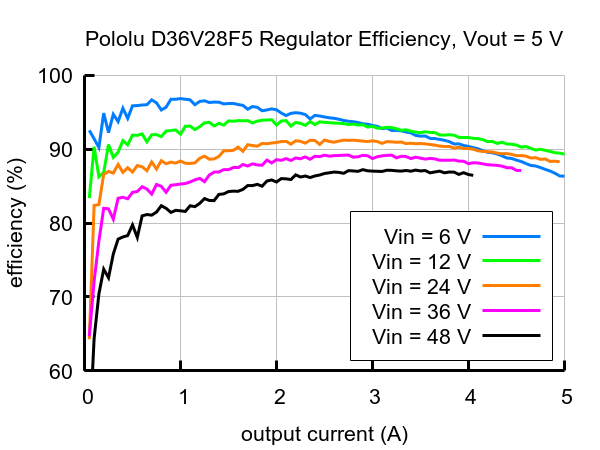 |
Maximum continuous output current
The maximum achievable output current of these regulators varies with the input voltage but also depends on other factors, including the ambient temperature, air flow, and heat sinking. The graph below shows maximum output currents that these regulators can deliver continuously at room temperature in still air and without additional heat sinking.
 |
During normal operation, this product can get hot enough to burn you. Take care when handling this product or other components connected to it.
Quiescent current
The quiescent current is the current the regulator uses just to power itself, and the graph below shows this for the different regulator versions as a function of the input voltage. The module’s EN input can be driven low to put the board into a low-power state where it typically draws between 10 µA and 20 µA per volt on VIN.
 |
Typical dropout voltage
The dropout voltage of a step-down regulator is the minimum amount by which the input voltage must exceed the regulator’s target output voltage in order to ensure the target output can be achieved. For example, if a 5 V regulator has a 1 V dropout voltage, the input must be at least 6 V to ensure the output is the full 5 V. Generally speaking, the dropout voltage increases as the output current increases. The graph below shows the dropout voltages for the different members of this regulator family:
 |
Specifications
| Parameter | Value |
|---|---|
| Size | 0.7″ × 0.8″ × 0.345″ |
| Weight | 3.3 g |
| Minimum operating voltage | 5.3 V |
| Maximum operating voltage | 50 V |
| Continuous output current | 3.2 A |
| Output voltage | 5 V |
| Reverse voltage protection? | Y |
| Maximum quiescent current | 3 mA |
| Output type | fixed 5V |
| PCB dev codes | reg24a |
| Other PCB markings | 0J11946 |
Resources
Returns and Refunds Policy
Returns
We offer exchanges or refunds for defective products within 30 days from the date of purchase.
To be eligible for a return, your item must be in the same condition that you received it. You will also be required to return the item along with its original packaging. Flammable goods, such as batteries, are exempt from being returned.
To request for a refund or exchange, please send us an email at contact@makersupplies.sg with a copy of your receipt or proof of purchase, and provide details on the suspected defect.
If eligible for defect inspection, please send your items to the following address via trackable Singapore Post Tracked Package:
MAKERSUPPLIES SG PTE LTD
BLOCK 4009 ANG MO KIO AVENUE 10
#03-36 TECHPLACE I
SINGAPORE 569738
State your name, order number and return address on the back of the envelope. Postage costs for returned parcels will be borne by customers. If the product defect is found to be true upon inspection on our side, then we will initiate the exchange or refund process.
NOTE: Please do not send your item/s back before receiving an acknowledgement email from us.
Exchanges
Same-item exchanges will be approved on a case-by-case basis and are subjected to the following factors:
- Validity of the proof of purchase by the buyer
- Extent of the product defect
- Availability of stock for replacement
If you are eligible for an exchange, we will arrange for the exchanged item/s to be delivered to your address at no additional charge.
However, if no reasonable defect is found, you will be responsible for paying for your own re-shipping fees.
Depending on where you live, the time it may take for your exchanged product to reach you may vary.
Refunds
If an exchange for the defective item is not viable, we will offer a refund instead.
Upon approval, your refund will be processed to your credit card or original method of payment.
Late or missing refund
If you have not received a refund yet, please check your bank account again.
Then contact your credit card company, it may take some time before your refund is officially posted.
Next contact your bank. There is often some processing time before a refund is posted.
If you’ve done all of this and you still have not received your refund yet, please contact us at contact@makersupplies.sg.
Sale items
Sale items cannot be refunded or exchanged.

